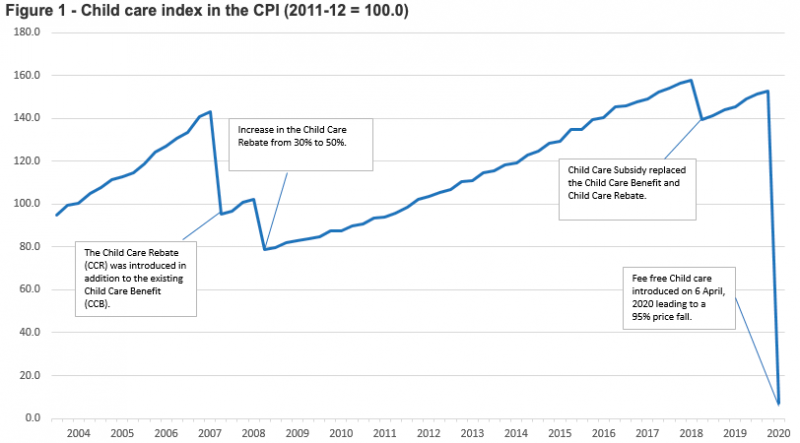- The Australian Bureau of Statistics (ABS) has revealed the recent government-backed free child care scheme had a major impact on the consumer price index (CPI) over the June quarter
- Though child care contributes just 1.2 per cent of household expenditure in the CPI, the free child care scheme took away 1.1 percentage points from headline CPI over the quarter
- Analysts are suggesting that, combined with petrol prices, this could bring about the largest-ever fall in CPI in the second quarter and even take annual inflation into negative territory
- CPI assesses the average change in the price of basket household goods and services — usually to assess inflation
- As a general rule, a steady rate of inflation is an indicator of economic growth
The Australian Bureau of Statistics (ABS) has revealed the recent government-backed free child care scheme had a major impact on the consumer price index (CPI) over the June quarter.
Simply speaking, the CPI measures the average change in the price of basket household goods and services over a period of time. Generally, the index is used to assess the average cost of living in a country and measure inflation, deflation, or stagflation.
In early April, the Federal Government revealed it would make child care free from April 6 until June 28. The scheme was later extended to July 12.
Now, as the scheme nears its close, the ABS has revealed the free child care scheme took away roughly 1.1 percentage points from headline CPI. When combined with the sharp fall in petrol prices over 2020 so far, analysts are suggesting this could bring about the biggest-ever fall in CPI in the second quarter and even take annual inflation into negative territory.
Why so steep?
According to the statistics bureau, child care contributes 1.2 per cent of household expenditure in the CPI, measured through changes in out-of-pocket expenses for families.
Though the weighting of child care is relatively small, the full decline of the service’s price is unprecedented. The below graph summarises Australian child care support schemes over almost two decades and their impact on the child care price series.

It’s not the weighting of the service, then, but the severe price fall that impacted CPI. For 62 out of the 65 business days in the June quarter, households spent nothing on child care.
Of course, with the scheme ending next week, the September quarter will be the inverse of June — child care prices will pick up right where they left off and CPI will likely increase again over the September quarter.
Is this a good or a bad thing?
Inflation, as measured by the CPI, is generally seen as a good thing. While too much inflation too quickly can suffocate an economy, a steady rise in inflation is often an indicator of economic growth. In fact, a key role of the Reserve Bank of Australia since the early 1990s has been to try to maintain a steady inflation rate of between two and three per cent.
On the other hand, lower overall prices mean consumers get more bang for their buck. As such, in a financially difficult time — such as a once-in-a-lifetime global pandemic — a short period of low inflation or even deflation could give consumer confidence enough of a boost to keep the economy steady. The risk is that ongoing deflation is a sign that the economy is shrinking, which could have devastating long-term effects.
In light of this, the huge quarterly drop in CPI might initially ring some alarm bells to investors and consumers. However, if the ending of the child care scheme helps offset this over the next quarter, things might not be as bad as they seem.
Of course, with fresh lockdowns in Victoria introduced today after a new wave of coronavirus infections, it’s clear the end of the pandemic is not yet in sight — meaning it’s uncertain how further government policies and economic uncertainty will affect future inflation.






